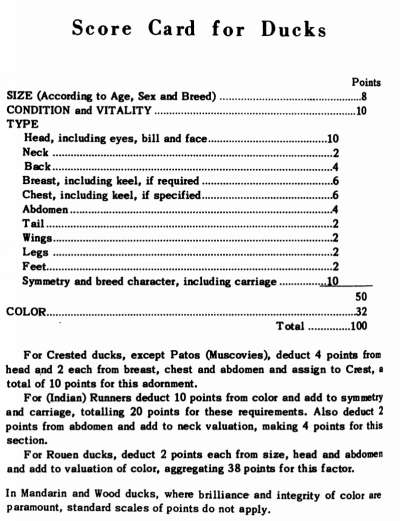Magpie: Difference between revisions
No edit summary |
No edit summary |
||
| Line 36: | Line 36: | ||
In shape the Magpie is rather long and racy and is a good forager and very active. | In shape the Magpie is rather long and racy and is a good forager and very active. | ||
The head is long and straight with a long nicely proportioned bill, very slightly dished. | The head is long and straight with a long, broad and nicely proportioned bill, very slightly dished. | ||
The eyes are large and prominent; dark in color. | The eyes are large and prominent; dark in color. | ||
Revision as of 02:00, 5 December 2020
| Magpie | |||
|---|---|---|---|
| Origin | Category | Egg Colour | Sitter |
| England | Light Breed Duck | White | Yes |
An English duck, which formerly enjoyed a considerable following, but has become a rarely-kept rare breed is the Magpie duck, a black and white breed of rather racy appearance and medium size, with a moderately uptight carriage.
The Magpie was bred after the end of the First World War by M.C. Gower-Williams in Wales and Oliver Drake in Yorkshire.The ancestry of the breed is not known; it may have included the Indian Runner. The Magpie duck colour pattern was developed to help achieve birds which would show no dark stubs on its breast when plucked out.
Appleyard says of this breed: "To breed a bird with perfect markings of good sound color is not too easy; however, this adds interest to the breed. It certainly is a most useful duck, because it will be noticed that the markings are so placed that when a bird is dead and plucked there are no black or colored stubs to show on the breast; in other words, they pluck out just as clean as a white duck."
The Magpie is first documented in 1920; a breeders' club was formed in 1926. At that time, two colour varieties were recognised, black-and-white and blue-and-white.
The Magpie was exported to the United States in 1963, but was not widely kept. It was admitted to the American Standard of Perfection in 1977.
The early strain, it was said, would produce 185 large eggs a year and achieve 4-6lbs in weight at 11 weeks old. They are a hardy variety, active foragers, and live for approximately 9 to 12 years.
GENERAL CHARACTERISTICS
Similar in shape to the Khaki Campbell, but more substantial, the Magpie is moderately streamlined with a somewhat upright carriage to around 35 degrees when active.
In shape the Magpie is rather long and racy and is a good forager and very active.
The head is long and straight with a long, broad and nicely proportioned bill, very slightly dished.
The eyes are large and prominent; dark in color.
The chest is rounded.
The neck is long and nicely curved and the moderately broad back is long, level and straight.
The tail is carried rather back adding to the apparent length of back.
The rump, thighs and underbody, white.
Males have, when fully feathered, curled feathers on the tail. Females have, when fully feathered, straight feathers on the tail.
COLOUR
Named for its distinctive black and white plumage, reminiscent of the colouration of the European magpie, the typical example of the breed is predominantly white with two large black areas on the back and top of the head. The colour pattern is that the head has a coloured cap above the eyes, the neck is white and the back, from the shoulders back over the top of wings to tail is black, blue or dun as the case may be which gives the bird the appearance of having a heart shaped mantle lying on the back. The remainder should be white. As the bird ages the black cap will normally begin to be flecked with white and may eventually become completely white.
Primaries and secondaries of the wings should be white and the upper part of wings black, blue or dun.
Blue, silver and chocolate which is very rare, are also colour varieties that Magpies can come in. However, blue is the only other variety besides black that is recognised by the American Poultry Association. In Australia only the Black is recognised.
The Black is a rich black, the Blue of a light shade and the Dun could be described as a light fawn with a greyish tinge. The Chocolate and White was added at a later time in Germany.
The bill is yellow or orange, but turns green in older birds.
The legs and feet are orange but some minor spotting is permissible.
WEIGHTS
- Males weigh around 2.7 kg (6.0 lb) on average,
- Females around 2.5 kg (5 1⁄2 lb).
Note: the American standard specifies 1 pound (0.45 kg) lower for each.
(Older info: weights given by Ives: Old drake 6 lbs.; Old duck 5 lbs.; Young drake 5 lbs.; Young duck 4.2 lbs.)
SCALE OF POINTS
SERIOUS DEFECTS
Coarseness and oversize is a defect in this breed as the Magpie is prized for alertness and a somewhat racy appearance.
SOURCES
- Australian Poultry Standards 2nd edition
- https://web.archive.org/web/20170630132859/http://www.poultryclub.org/img/Breed%20Classification.pdf
- Grow, O. (1956). Universal waterfowl standard and judging guide. Milwaukee: American Waterfowl Assoc., inc. https://babel.hathitrust.org/cgi/pt?id=coo.31924003128190&view=1up&seq=9
- Ives, Paul Pomeroy. Domestic Ducks and Geese. New York, Orange Judd publishing company, inc., 1951. https://babel.hathitrust.org/cgi/pt?id=coo.31924090294343&view=1up&seq=7

